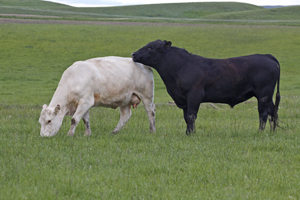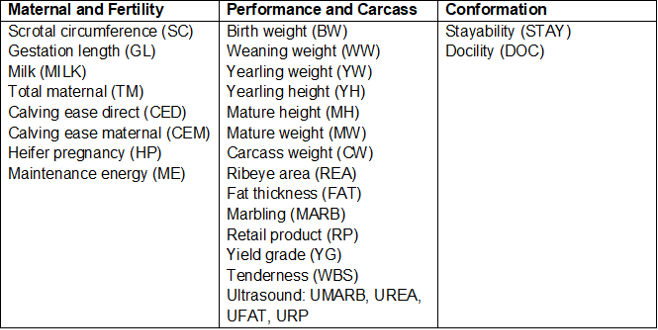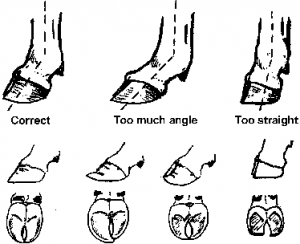Bull Selection: What are you looking for? 🎙️
Editor’s note: The following is part two of a four-part series that will help you to evaluate different breeding programs, which bulls are optimal for your herd, and how much they’re worth. (See part one).
CLICK THE PLAY BUTTON TO LISTEN TO THIS POST:
Bull selection is one of the most important decisions for cow-calf producers, with implications for short- and long-term profitability of the operation. The choice of bull can be immediately seen in the subsequent calf crop.

If the operation retains heifers and/or bulls, the genetics in the selected bull will be passed down to subsequent generations. Introducing new genetics is a permanent change to the herd, compared to the temporary nature of supplements or management practices. As such, bull selection can be seen as a long-term investment into the operation.
Research in the area of beef cattle genetics has been growing significantly. There are opportunities to improve profitability through sire selection. However, with a multitude of traits, breed differences, operational goals, and management practices, bull selection is a complex decision.
There are a range of different beef operations in Canada, and there is no one type of bull that is optimal for all operations. Bull selection depends on many factors such as management style, calving season, labour availability, age when calves are marketed, heifer retention practices, and nutritional management.
Before selecting a bull, operational goals should be established and the management and breeding practices (see Part 1) that fit those goals determined.
For example, a full-time producer who observes the cattle multiple times a day may not prioritize calving ease in a bull as much as an operation with limited labour. A farm with limited forage resources may prefer smaller cattle that are more efficient at converting low quality forage.
To assist with making bull selection decisions, consistent record keeping on the herd will help identify areas of strength and weakness in the herd and guide you towards the type of genetic change you want to see. Once operational goals and breeding programs have been determined a producer can focus in on specific Expected Progeny Differences (EPDs) to guide their bull selection.
Expected Progeny Differences (EPDs)
When selecting a bull, EPDs are a helpful tool to predict bull performance. EPDs are the estimation of an animals genetic merit. They are compared to a breed average (not zero) and cannot be compared across breeds. An explanation of EPDs can be found here and in NBCEC (2010).
Maternal and Fertility Traits
Table 2. Expected Progeny Difference (EPD) indicators by category

Calving ease is a key trait that influences profitability. It is estimated the majority of calf loss is a result of dystocia (difficulty calving). Dystocia results in higher labor costs, decreased calf survival, and delayed rebreeding for the cow resulting in younger calves at weaning the following year.
The EPD for calving ease takes into account numerous factors including birth weight. Studies suggest birth weight is the most important factor for calving ease – a one pound increase in birth weight increases the probability of dystocia by two percent (Herring, 1996). Birthweight, while important for calving ease, isn’t always a direct correlation, for example a larger frame score cow should have no problem giving birth to a 95 lb calf; whereas, a smaller frame score cow might, especially if that calf has a bigger head and shoulders. However, shoulder width and pelvic areas alone have not been shown to be useful predictors in calving ease (NBCEC, 2010). Purely focusing on low birth weights when selecting bulls can be ill-advised. As low birth weight is genetically correlated with weaning and yearling weights, such a breeding program may lead to lower growth performance (Herring, 1996).
“If an operation has low labour availability, a high proportion of heifers, calves on pasture or is a new producer with limited time and experience, calving ease should be prioritized” |
|---|
To determine the significance of calving ease in bull selection, the goals and type of operation should be taken into consideration. For example, if there is low labour availability, a high proportion of heifers, calving on pasture, or a new producer with limited time and experience, calving ease should be prioritized. On the flip side, an intensive operation focused on selling large calves may not find calving ease to be as important. Calving ease may also be an important trait if calving in late winter (i.e., February), as cold weather has been linked to larger calves and lower calf survivability (Hamilton, 2010).
Other traits of interest are milk production and bull fertility.
High milk production results in increased weaning weights. However, it raises energy requirements for cows even when they are not lactating. If the cow-calf operation has low forage availability, selecting for high milk production may lead to feed shortages and undernourished cattle. If running a terminal system and not retaining any heifers, the milk production trait becomes less relevant.
Bull fertility is linked to higher semen quality and quantity, as well as a lower age of puberty for his daughters.
Performance and Carcass Quality Traits
As already mentioned, there are potential trade-offs between birth weight and performance. A low birth weight may increase calving ease, but it is correlated with lower weaning weight. However, there are many cases where a low birth weight is warranted; for example, when labour availability is limited or when breeding heifers. A low birth weight can be compensated for by selecting for higher milk production; however, as milk production increases, the nutrient requirement of cows will also increase, although it’s not a direct 1:1 relationship. Selection for superior growth can lead to calving difficulty and cows too large for the existing forage resources.
When calves are marketed also affects bull selection. If calves are sold at weaning, producers can focus on traits associated with a higher weaning weight, such as milk production and weaning weight EPD. When ownership is retained, weaning weight is less of a priority, and the focus may shift to traits such as yearling weight and carcass indicators (e.g., carcass weight, ribeye area, fat thickness, marbling). EPDs can help remove some of the guessing game when it comes to carcass quality as visual appraisal of muscling does not have a strong link to carcass quality.
Conformation and Structural Soundness Traits

Bull conformation directly affects longevity, and his structural soundness is passed along to the cow herd. Conformation can be evaluated through visual appraisal. Key factors to look for are the bull’s ability to walk easily without discomfort, the slope and angle to the joints of the legs, free from defects of the claws (e.g. toes that cross over each other or turn up), and joints free of swelling and inflammation. Healthy legs and feet are particularly important for extensive operations and large pastures, especially if there is rough terrain or multiple bulls in a breeding field.
When looking at body condition, the goal is to choose a bull with a moderate score. If the score is low, the bull’s performance is reduced as they lose weight during the breeding season. If the body condition score is too high, sperm quality and stamina are adversely affected.
Temperament is another consideration for bull selection. Bulls that are aggressive, nervous, or flighty may be undesirable due to safety concerns (e.g. older operators or young children) or damage to facilities. On the other hand, as temperament is moderately heritable, overly docile cows can pose an issue if calving on pasture where predation is a concern.
Conclusion
There is no one-size-fits-all solution or a bull that is best for all scenarios, as the right genetics depend on the individual operation. Key EPDs include:
- maternal and fertility traits (e.g. calving ease, milk production, bull fertility),
- trade-offs between performance and carcass quality traits,
- conformation and structural soundness.
For example, labour availability during calving season and how closely females are monitored will determine the emphasis on calving ease and birth weight EPDs when selecting a bull. Or if marketing calves at weaning or retaining ownership will influence trade-off producers are willing to live with. Is the higher birth weight and time spent at calving worthwhile come sale day when you see that weaning weight?
There are many different types of bulls available, and effective sire selection requires an understanding of the characteristics of the available genetics as well as your own operation. Deliberate alignment of the bull’s genetics to your operational goals will contribute to enhanced revenue and reduced costs.
Editor’s note: Part three in this four-part series is available here.
- Resources
- Beef Improvement Federation (BIF) resources https://beefimprovement.org/library-2/fact-sheets
- Kuehn, L. and M. Thallman. 2018 Across-Breed EPD Table and Improvements. Beef Improvement Federation (BIF) https://beefimprovement.org/wp-content/uploads/2019/01/18_ABEPDpressreleaseandfactsheet.pdf
- EPDs: What do all those numbers mean? (BCRC Blog post)
- National Beef Cattle Evaluation Consortium (NBCEC). (2010). Beef Sire Selection Manual 2nd Edition. http://www.nbcec.org/producers/sire_selection/manual.pdf
- Gosey, J.A. (1991). Crossbreeding Systems and The Theory Behind Composite Breeds. http://digitalcommons.unl.edu/cgi/viewcontent.cgi?article=1235&context=rangebeefcowsymp
- Weaber, R.L. (2015). Crossbreeding Strategies: Including Terminal Vs. Maternal Crosses. http://digitalcommons.unl.edu/cgi/viewcontent.cgi?article=1331&context=rangebeefcowsymp
- References
- Agriculture Victoria (2017). Breeds of Beef Cattle. https://www.parliament.vic.gov.au/file_uploads/Breeds_of_beef_cattle_8pHy2kN0.pdf Accessed January 16, 2019.
- Evans, J. and McPeake, C.A. Crossbreeding Beef Cattle I. http://pods.dasnr.okstate.edu/docushare/dsweb/Get/Rendition-2051/unknown Accessed January 20, 2019.
- Gaines, J. A., McClure, W. H., Vogt, D. W., Carter, R. C., & Kincaid, C. M. (1966). Heterosis from crosses among British breeds of beef cattle: Fertility and calf performance to weaning. Journal of Animal Science 25(1): 5-13.
- Gosey, J.A. (1991). Crossbreeding Systems and The Theory Behind Composite Breeds. http://digitalcommons.unl.edu/cgi/viewcontent.cgi?article=1235&context=rangebeefcowsymp Accessed January 20, 2019.
- Gregory, K. E., Cundiff, L. V., Koch, R. M., Laster, D. B., & Smith, G. M. (1978). Heterosis and Breed Maternal and Transmitted Effects in Beef Cattle I. Preweaning Traits 1, 2, 3, 6, 7. Journal of Animal Science 47(5), 1031-1041.
- Hamilton, T. (2010). Summer Calving Can Be Super! http://www.omafra.gov.on.ca/english/livestock/beef/facts/info_summer_calving.htm Accessed January 20, 2019.
- Herring, W.O. 1996. Calving Difficulty in Beef Cattle: BIF Fact Sheet. https://extension2.missouri.edu/g2035 Accessed January 20, 2019.
- Koger, M. (1980). Effective crossbreeding systems utilizing Zebu cattle. Journal of Animal Science 50:1215.
- MacNeil, M. D. (2009). Invited review: Research contributions from seventy-five years of breeding Line 1 Hereford cattle at Miles City, Montana. Journal of Animal Science 87(8): 2489-2501.
- National Beef Cattle Evaluation Consortium (NBCEC). (2010). Beef Sire Selection Manual 2nd Edition. http://www.nbcec.org/producers/sire_selection/manual.pdf Accessed January 20, 2019.
- Northcutt, S.L., Buchanan, D.S., & Clutter, A.C. Inbreeding in Cattle. http://pods.dasnr.okstate.edu/docushare/dsweb/Get/Document-1974/ANSI-3165web.pdf Accessed January 16, 2019.
- Turner, J. W., Farthing, B. R., & Robertson, G. L. (1968). Heterosis in reproductive performance of beef cows. Journal of Animal Science 27(2): 336-338.
- van der Westhuizen, B. (2016) Inbreeding vs Linebreeding. http://www.ngunicattle.info/Publications/Journals/2016/Inbreeding%20vs%20line-breeding.pdf Accessed January 20, 2019.
Click here to subscribe to the BCRC Blog and receive email notifications when new content is posted.
The sharing or reprinting of BCRC Blog articles is welcome and encouraged. Please provide acknowledgement to the Beef Cattle Research Council, list the website address, www.BeefResearch.ca, and let us know you chose to share the article by emailing us at info@beefresearch.ca.
We welcome your questions, comments and suggestions. Contact us directly or generate public discussion by posting your thoughts below.